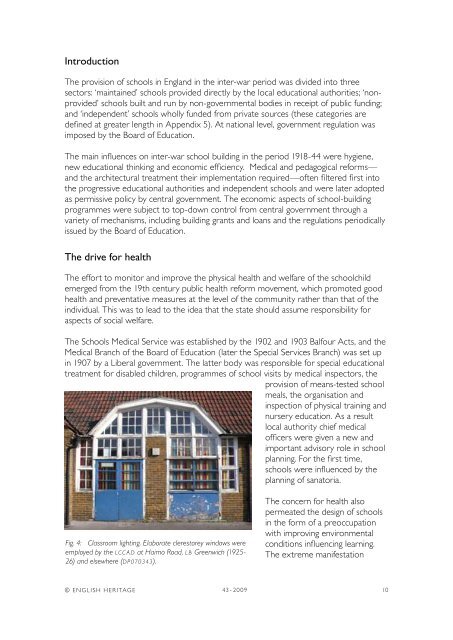innerâlondon schools 1918â44 a thematic study - English Heritage
innerâlondon schools 1918â44 a thematic study - English Heritage
innerâlondon schools 1918â44 a thematic study - English Heritage
- No tags were found...
You also want an ePaper? Increase the reach of your titles
YUMPU automatically turns print PDFs into web optimized ePapers that Google loves.
IntroductionThe provision of <strong>schools</strong> in England in the inter-war period was divided into threesectors: ‘maintained’ <strong>schools</strong> provided directly by the local educational authorities; ‘nonprovided’<strong>schools</strong> built and run by non-governmental bodies in receipt of public funding;and ‘independent’ <strong>schools</strong> wholly funded from private sources (these categories aredefined at greater length in Appendix 5). At national level, government regulation wasimposed by the Board of Education.The main influences on inter-war school building in the period 1918-44 were hygiene,new educational thinking and economic efficiency. Medical and pedagogical reforms—and the architectural treatment their implementation required—often filtered first intothe progressive educational authorities and independent <strong>schools</strong> and were later adoptedas permissive policy by central government. The economic aspects of school-buildingprogrammes were subject to top-down control from central government through avariety of mechanisms, including building grants and loans and the regulations periodicallyissued by the Board of Education.The drive for healthThe effort to monitor and improve the physical health and welfare of the schoolchildemerged from the 19th century public health reform movement, which promoted goodhealth and preventative measures at the level of the community rather than that of theindividual. This was to lead to the idea that the state should assume responsibility foraspects of social welfare.The Schools Medical Service was established by the 1902 and 1903 Balfour Acts, and theMedical Branch of the Board of Education (later the Special Services Branch) was set upin 1907 by a Liberal government. The latter body was responsible for special educationaltreatment for disabled children, programmes of school visits by medical inspectors, theprovision of means-tested schoolmeals, the organisation andinspection of physical training andnursery education. As a resultlocal authority chief medicalofficers were given a new andimportant advisory role in schoolplanning. For the first time,<strong>schools</strong> were influenced by theplanning of sanatoria.Fig. 4: Classroom lighting. Elaborate clerestorey windows wereemployed by the LCC AD at Haimo Road, L B Greenwich (1925-26) and elsewhere (DP070343).The concern for health alsopermeated the design of <strong>schools</strong>in the form of a preoccupationwith improving environmentalconditions influencing learning.The extreme manifestation© ENGLISH H ER I TAG E 43 - 20 0910
















